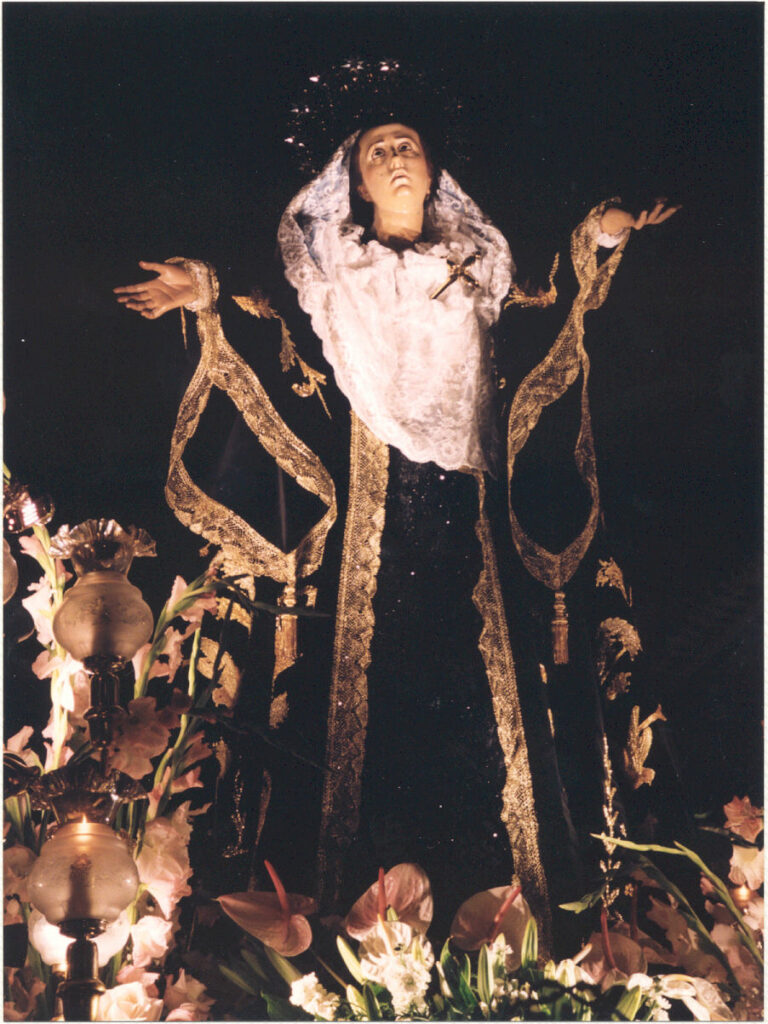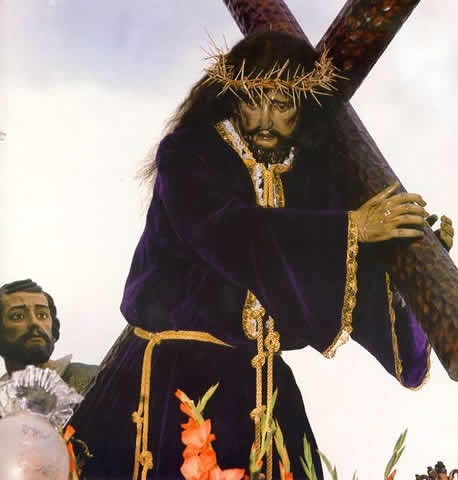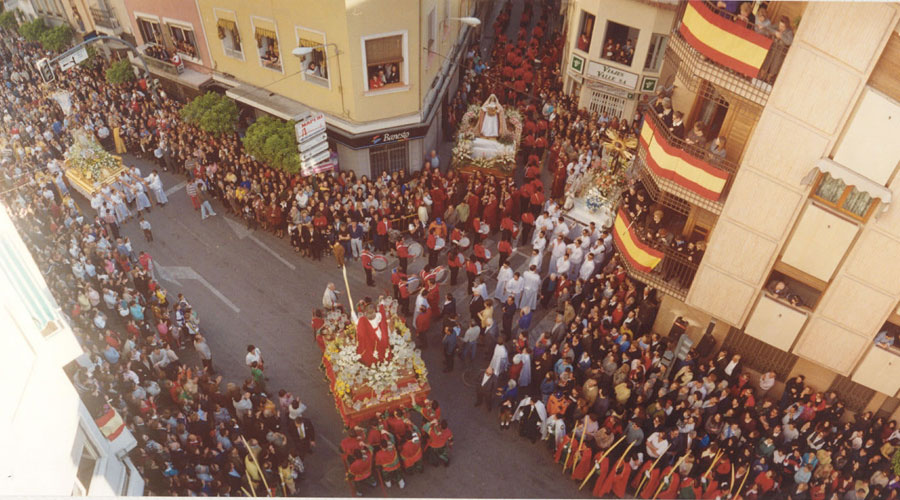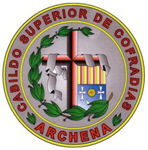

Easter Week in Archena was declared a Festival of Regional Tourist Interest in 1995. The Cabildo Superior de Cofradías is made up of twelve brotherhoods and sisterhoods which organise all the processions.
After the triduums and different Lenten events that begin on Ash Wednesday, the events of Holy Week in Archena begin on the Sunday before Palm Sunday, with the Easter Proclamation that always takes place in the Parish Church of San Juan Bautista, after the twelve o’clock mass. The first of the processions organised by the different brotherhoods and sisterhoods is that of Friday of Sorrows, the Via Crucis, in which only the Virgen de los Dolores parades, with her throne and corresponding image.
On Palm Sunday, at ten o’clock in the morning, the procession of the palms takes place, at the end of which Holy Mass is celebrated. For centuries, the purchase of palms for Palm Sunday, which were then distributed among the local residents, has been one of the Archena Town Council’s fixed expenses. Nowadays it is the Cabildo, which is subsidised by the municipality, which is responsible for their purchase.
On Easter Monday there is no procession, but there is a Way of the Cross organised by the Cofradía de las Ánimas (Brotherhood of the Souls), which leaves at night from the Corpus Christi parish church. On Holy Tuesday, the people of Archena take to the streets in the Procession of Forgiveness, which is the first to begin at night and includes the following thrones: the Prayer in the Garden, the Denial of St. Peter, the Jesus of the Rescue, the Christ of the Scourging, the Christ of Forgiveness, the Pietà and the Solitude. On Holy Wednesday, the Procession of the Prendimiento takes to the main streets of the centre of Archena with eight thrones, most of which depict the Passion of Jesus Christ. The emblematic Cross of the Mirrors starts the procession, followed by the Ecce Homo, the Roman Centuria, popularly known as the company of the Armaos, the Cristo del Gran Poder, the Cristo de la Agonía, the Cristo de la Sangre, San Juan Evangelista, and finally La Dolorosa.


On Maundy Thursday, commemorating the death of the Saviour, we could say that there is no procession, because the so-called Procession of Silence and Stations of the Cross leaves at exactly 24.00 hours, parading a single throne, that of the Christ of Mount Calvary, so in reality it is one of the three that correspond to Good Friday.
This is the most important day in Archena’s Holy Week, undoubtedly the most exciting and exhausting day for the brothers and sisters and the brotherhoods, who, in addition to this day, take two other processions out onto the streets. At nine o’clock in the morning the so-called Encuentro Doloroso (Sorrowful Meeting) takes place after the Easter Sermon in the Plaza de España, after which the longest procession begins its route, the Procession of the Sorrowful Meeting, made up of thirteen thrones: La Cruz de los Espejos, La Samaritana, La Cena, La Oración del Huerto, El Cristo de los Azotes, La Verónica, Nuestro Padre Jesús Nazareno, La Centuria Romana (Los Armaos), El Cristo del Gran Poder, El Cristo de la Agonía, El del Monte Calvario, San Juan Evangelista and La Dolorosa.
At the end of the services, a singular ceremony takes place: the uncloaking of the Crucified Christ, who is then paraded lying on the tomb. The author of this carving is the only sculptor from Archena, Enrique Salas, who is also the creator of the Cruz de los Espejos (Cross of the Mirrors). From half past nine in the evening the streets of Archena are filled with the carvings, flowers, lights and penitents that make up the Procession of the Holy Burial. It is preceded as usual by the Cross of the Mirrors, followed by the Christ of the Blood, María Magdalena, the Christ of Forgiveness, the Descent from the Cross, the Pietà, the Stairway Cross, the Holy Sepulchre, the Armaos, San Juan Evangelista and La Dolorosa.
After the processional apotheosis of Good Friday, the Saturdayonly organises one Easter Vigil.
Easter Sunday is, logically, the most festive and joyful day. In the early hours of the morning the Glorious Encounter between St. John, the Virgin, Mary Magdalene, the Cross and the Risen Christ, with the dance of the steps carried by the so-called “anderos”, and the release of doves and balloons amidst a veritable shower of sweets.
Subsequently the Procession of the Risen Christ, in which the aforementioned thrones take part, brings the Semana Santa archenera to a close.


Confraternity of the Holy Cross of the Mirrors
Founded: late 19th century
Passages: Holy Cross of the Mirrors, St. Peter
Attire: white
Confraternity of the Veronica, Christ of the Blood and the Samaritan woman
Founded: 1943
Passages: The Veronica, Stmo. Cristo de la Sangre, The Samaritan woman.
Costume: red
Royal Brotherhood of St. Christ of Forgiveness
Founded: 1947
Passages: Stmo. Cristo del Perdón, Cristo amarrado a la columna, La Oración del Huerto, Stma. Virgen de la Soledad.
Attire: red and black
Brotherhood of the Santísimo Cristo del Gran Poder
Founded: 1988
Passages: Santísimo Cristo del Gran Poder, Descent of Jesus.
Attire: black and gold
Guild of the Most Holy Christ of the Agony and St. Mary Magdalene
Founded: 1994
Passages: Stmo. Cristo de la Agonía, Stma. María Magdalena
Attire: maroon velvet
Confraternity of the Holy Christ of Mount Calvary
Founded: 1960
Passages: Christ Crucified (articulated), Cross of the Ladder
Attire: yellow and purple
Brotherhood of Animas
Founded: 1774
Passages: Our Father Jesus of Nazareth, Ecce Homo, Holy Supper, Holy Sepulchre.
Attire: purple
Brotherhood of the Risen Christ
Founded: Late 19th century
Passages: Saint John the Evangelist
Attire: green and red
Confraternity of Our Lady of Consolation and Holy Women of Jerusalem
Founded: 1778
Procession: Our Lady of Sorrows
Attire: blue
Our Father Jesus of Nazareth and Holy Sepulchre
Founded: 2002
Passages: Stmo. Cristo de las Ánimas
Attire: off-white and black
Brotherhood of Saint John the Evangelist
Founded: 1954
Passages: Risen Christ
Attire: white and gold
Brotherhood of the Holy Virgin of Dolores
Founded: 2013
Passages: Our Lady of Consolation and Holy Women, St. Mary of Cleophas and St. Mary Salome.
Attireb black and pink
We firmly believe that the internet should be available and accessible to anyone, and are committed to providing a website that is accessible to the widest possible audience, regardless of circumstance and ability.
To fulfill this, we aim to adhere as strictly as possible to the World Wide Web Consortium’s (W3C) Web Content Accessibility Guidelines 2.1 (WCAG 2.1) at the AA level. These guidelines explain how to make web content accessible to people with a wide array of disabilities. Complying with those guidelines helps us ensure that the website is accessible to all people: blind people, people with motor impairments, visual impairment, cognitive disabilities, and more.
This website utilizes various technologies that are meant to make it as accessible as possible at all times. We utilize an accessibility interface that allows persons with specific disabilities to adjust the website’s UI (user interface) and design it to their personal needs.
Additionally, the website utilizes an AI-based application that runs in the background and optimizes its accessibility level constantly. This application remediates the website’s HTML, adapts Its functionality and behavior for screen-readers used by the blind users, and for keyboard functions used by individuals with motor impairments.
If you’ve found a malfunction or have ideas for improvement, we’ll be happy to hear from you. You can reach out to the website’s operators by using the following email
Our website implements the ARIA attributes (Accessible Rich Internet Applications) technique, alongside various different behavioral changes, to ensure blind users visiting with screen-readers are able to read, comprehend, and enjoy the website’s functions. As soon as a user with a screen-reader enters your site, they immediately receive a prompt to enter the Screen-Reader Profile so they can browse and operate your site effectively. Here’s how our website covers some of the most important screen-reader requirements, alongside console screenshots of code examples:
Screen-reader optimization: we run a background process that learns the website’s components from top to bottom, to ensure ongoing compliance even when updating the website. In this process, we provide screen-readers with meaningful data using the ARIA set of attributes. For example, we provide accurate form labels; descriptions for actionable icons (social media icons, search icons, cart icons, etc.); validation guidance for form inputs; element roles such as buttons, menus, modal dialogues (popups), and others. Additionally, the background process scans all of the website’s images and provides an accurate and meaningful image-object-recognition-based description as an ALT (alternate text) tag for images that are not described. It will also extract texts that are embedded within the image, using an OCR (optical character recognition) technology. To turn on screen-reader adjustments at any time, users need only to press the Alt+1 keyboard combination. Screen-reader users also get automatic announcements to turn the Screen-reader mode on as soon as they enter the website.
These adjustments are compatible with all popular screen readers, including JAWS and NVDA.
Keyboard navigation optimization: The background process also adjusts the website’s HTML, and adds various behaviors using JavaScript code to make the website operable by the keyboard. This includes the ability to navigate the website using the Tab and Shift+Tab keys, operate dropdowns with the arrow keys, close them with Esc, trigger buttons and links using the Enter key, navigate between radio and checkbox elements using the arrow keys, and fill them in with the Spacebar or Enter key.Additionally, keyboard users will find quick-navigation and content-skip menus, available at any time by clicking Alt+1, or as the first elements of the site while navigating with the keyboard. The background process also handles triggered popups by moving the keyboard focus towards them as soon as they appear, and not allow the focus drift outside of it.
Users can also use shortcuts such as “M” (menus), “H” (headings), “F” (forms), “B” (buttons), and “G” (graphics) to jump to specific elements.
We aim to support the widest array of browsers and assistive technologies as possible, so our users can choose the best fitting tools for them, with as few limitations as possible. Therefore, we have worked very hard to be able to support all major systems that comprise over 95% of the user market share including Google Chrome, Mozilla Firefox, Apple Safari, Opera and Microsoft Edge, JAWS and NVDA (screen readers), both for Windows and for MAC users.
Despite our very best efforts to allow anybody to adjust the website to their needs, there may still be pages or sections that are not fully accessible, are in the process of becoming accessible, or are lacking an adequate technological solution to make them accessible. Still, we are continually improving our accessibility, adding, updating and improving its options and features, and developing and adopting new technologies. All this is meant to reach the optimal level of accessibility, following technological advancements. For any assistance, please reach out to
